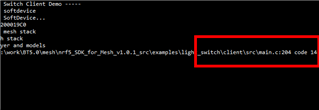I have created three nodes(A, B, C) one client(i.e A) and two servers (i.e B and C) using simple_message_model. The node that contains the client model(A node) provision the two other nodes(B and C). Now after provisioning the node. I have kept the nodes such that (A->B->C) B is in range of A. C is in range of B but C is not in range of A. I have call the access_model_publish() on press of switch 0. which sends the message from A to B node. B node is control node contains client as well as server model (i.e it acts as a relay node.) When B receives the message it calls access_model_publish to send the received message to node C. But in my example it seems that B receives the message but C not receives the message. after sending message from B it returns status 0 still C not receives the message. Is there any need to do the access layer setup (access_setup)?. I am not able to find the actual cause of this problem. Will you please help to solve the problem?
Thanks in advance.




